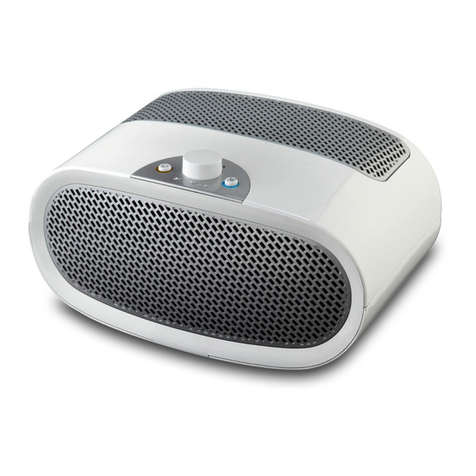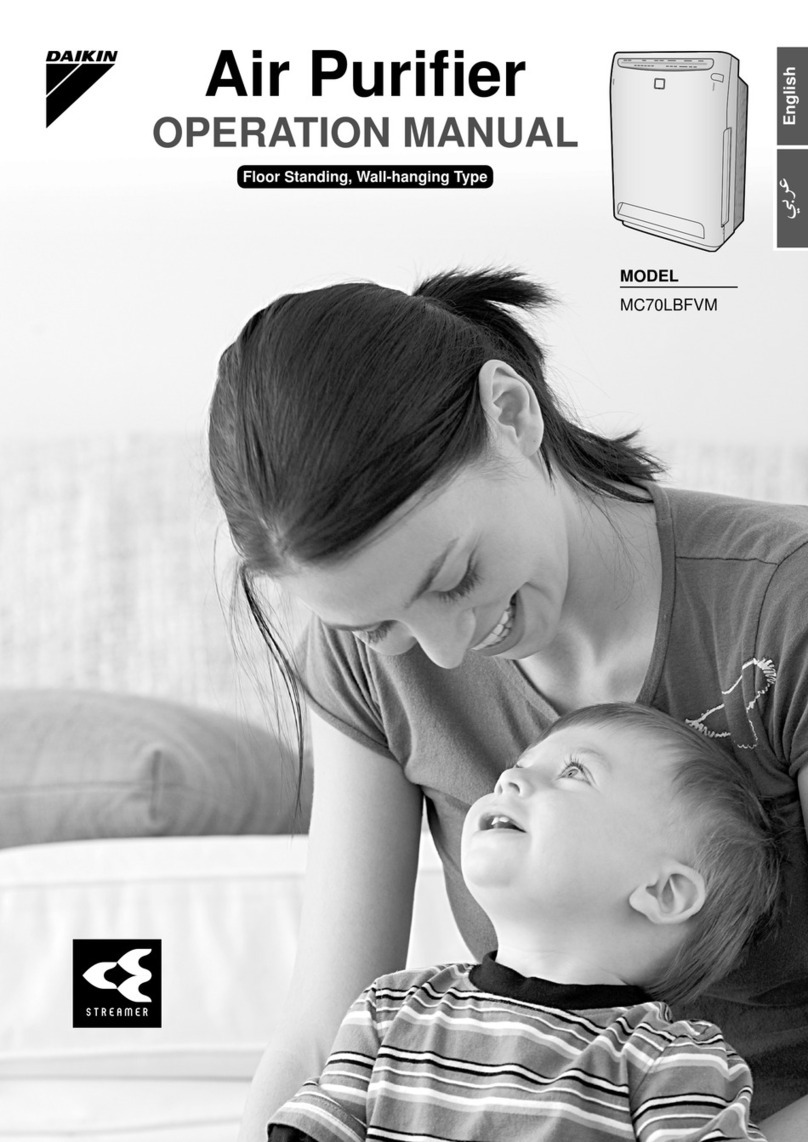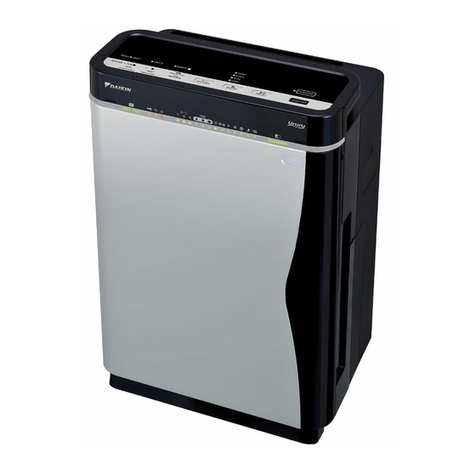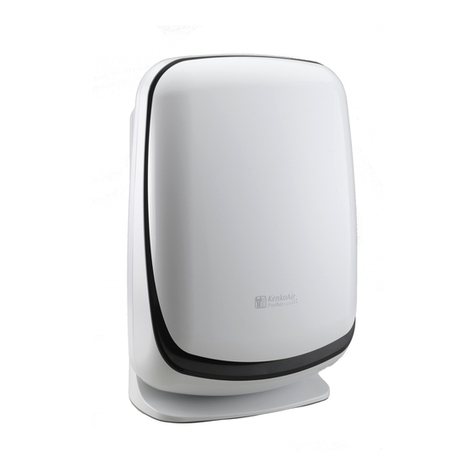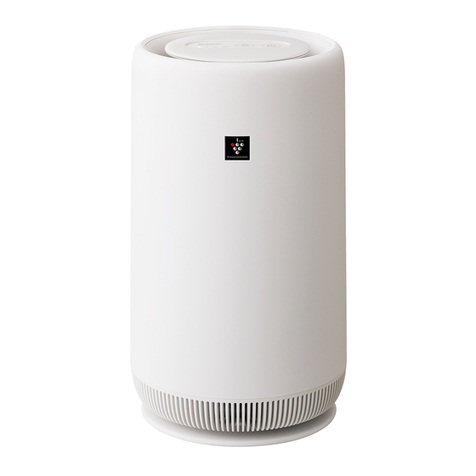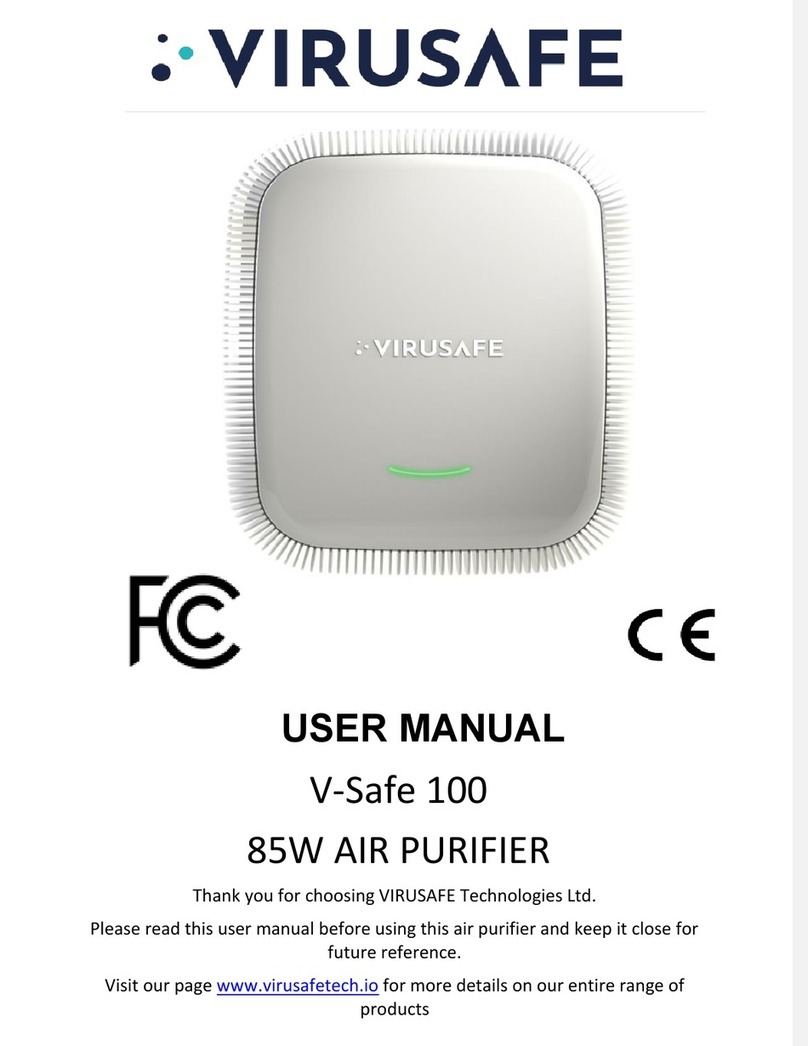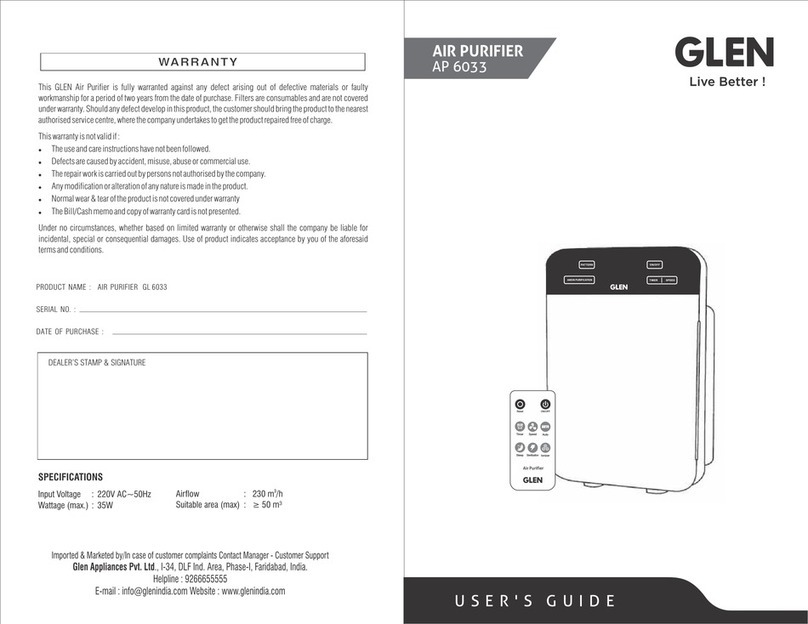Seeley Breezair EXV User manual

(English) (EXV)
EXV Evaporative Cooler
INSTALLATION & OPERATION MANUAL

INDEX
SAFETY
INSTALLATION INSTRUCTIONS
TROUBLE SHOOTING
APPENDIXA
......................................................................................................... 1
Using the Remote Control................................................. 3
Maintenance.................................................................................................. 9
Pre-Assembly Inspection............................................................................... 10
Installation Details.......................................................................................... 11
Water Installation........................................................................................... 12
Electrical Installation...................................................................................... 13
Installation Checklist...................................................................................... 18
................................................................................. 19
- Wiring Diagrams..................................................................... 21
OPERATING INSTRUCTIONS
Thermostat Range......................................................................................... 2
Using the Wall Control......................................................... 7
Wall Control........................................................................ 13
Remote Control................................................................... 14
Testing the cooler........................................................................................... 16
SENSOR
SENSOR
SENSOR
SENSOR
TOUCH
TOUCH
TOUCH
TOUCH
1EXV Evaporative Cooler

SAFETY INSTRUCTIONS
Important Safety Instructions and
Warnings
Read this entire manual before
proceeding to install the cooler.
Failure to observe these warnings
and instructions will void
manufacturer's warranties and will
discharge the manufacturer of all
liability.
!
ALWAYS disconnect the cooler
from the power supply before
commencing maintenance
procedures.
Avoid Dangerous Situations:
Protect the cooler from all
sources of ignition because
polymers and cooling pads will
burn.
WARNING: The warnings and safety
instructions in this manual must be
followed to reduce the risk of fire,
electric shock or injury, and to provide
reasonable safety and efficiency in
using this Evaporative Air Cooler. The
operator is responsible for following the
warnings and instructions in this
manual and on the cooler.
During maintenance procedures,
NEVER use a naked flame for any
inspection or cleaning purpose as
a fire could be caused by a flame
coming into contact with the cooler
materials.
NEVER use a water hose to squirt the
interior of the cooler for cleaning as
residual water could damage electrical
components and create the risk of fire
and /or electric shock to the user after
re-assembly.
CAUTION
This appliance is not intended for
use by persons (including children)
with reduced physical, sensory or
mental capabilities, or lack of
experience and knowledge, unless
they have been given supervision or
instruction concerning use of the
appliance by a person responsible
for their safety.
Safety
WATER PUMP
Under no circumstances are
"Power Clean" style timed pumps
to be used in any Breezair
evaporative air cooler.
Failure to follow this
instruction will VOID ALL
WARRANTY and may create severe
risk of electric shock and fire!
FAN MOTOR
Failure to follow this instruction will
VOID ALL WARRANTY and may
create severe risk of electric shock
and fire!
CIRCUIT BREAKER PROTECTION
The water pump is supplied with this
cooler and is factory fitted into its
correct location.
Ensure that it is properly secured and
upright as intended.
There is no need to adjust the water
flow since the cooler is designed to
operate with maximum cooling at low
air velocities.
Factory authorized pumps are fitted
with thermal overload protection.
Water pumps may seize up and
overheat, creating a fire risk. Pumps
that have thermal overload protection
are designed to shut off the pump if
the motor overheats.
Seeley "Tornado" pump (part no.
095851)
Use of these
devices or any other non-approved
device will cause serious damage to
the special safety circuits of this
cooler.
This cooler is supplied with a fan
motor made by the cooler
manufacturer. USE ONLY THE
AUTHORIZED FAN MOTOR
SUPPLIED.
Seeley Variable Speed motors:
550W (3/4HP) motor part # 095118
750W (1HP) motor part # 095125
The fan motor is equipped with inbuilt
overheating protection that will reset
automatically on cool-down to a safe
temperature. This may take up to 45
minutes.
This cooler is fitted with circuit breaker
protection for the fan motor and pump.
Water pump replacement
Factory Authorized water pump
“Power Clean" Style Timed Pumps
FactoryAuthorized Fan Motor
INSTALLATION, REPAIR AND
OPERATION
!
!
!
!
!
!
!
!
!
!
!
!
!
!
Disconnect electrical power at the fuse or
circuit breaker box before installation
commences. ALWAYS turn OFF the isolating
switch (disconnect) located on the electronic
module inside the cooler BEFORE
commencing any maintenance procedures
Keep children, bystanders and animals at
a safe distance, a minimum of 30ft (10m)
away from working areas.
Dress safely. Wear non-skid shoes when
working at high levels and roofs. Do not
wear loose clothing or personal accessories
while installing or servicing the air cooler as
they may become caught in moving parts.
Keep loose hair, loose clothing, fingers
and all other parts of the body away from
openings and moving parts.
Check the cooler for worn, loose, missing,
or damaged parts before operation.
If you work with power tools, wear
protective eyewear and gloves.
Take care when lifting or raising the air
cooler to its final location. Use safe
equipment and never attempt to lift the
cooler alone. Always have assistance.
Otherwise you might damage the cooler or
the building or injure yourself.
Ground Fault Circuit Interrupter (GFCI)
protection should be provided on the circuit
supplying this air cooler. Receptacles are
available with built-in GFCI protection.
Air coolers installed on roofs must not
have the waste water directed onto the roof
as stains will occur. Connect the cooler drain
outlet to a gutter or drain pipe using a
suitable hose.
Always use the correct tools.
the packaging plastic on this
cooler can be a safety hazard. Dispose of
carefully.
Never drill holes in the pan or walls of the
cooler.
Avoid dangerous situations. Do not use
the cooler in the presence of flammable
liquids or gasses to avoid creating fire or
explosion. This air cooler is NOT flame
retardant. A fire may result from contact with
a flame or from an electrical short.
Use of wrong replacement parts creates
risk of severe electric shock and fire which
may result in serious property damage,
personal injury or death.
Use only the power supply voltage shown
on the motor/cabinet nameplate.
Do not install or service the air cooler
during rain, high wind or severe weather
conditions.
!
!
!WARNING
!
!
All installation and repair work must
conform to local electrical, water supply
and environmental codes, rules and
regulations and applicable national
standards.
All installation, maintenance and
repair work must be done by a
licensed and qualified electrician
and/or a qualified, experienced
heating, ventilating, air conditioning
technician. All such work must be
effected with factory authorized
spare parts only.
SEELEY INTERNATIONAL – INSTALLATION & OPERATION MANUAL 2

Thermostat Range
Wall Mounted Thermostat Control
(wall control)
Remote Thermostat Control
(remote control)
AUTO COOL
PM
FAN
SPEED
ECONOMY
REMOTE CONTROL
ILL239-D
ILL1140-A
thermostat range
SENSORTOUCH SENSORTOUCH
3EXV Evaporative Cooler

SENSORTOUCH Remote Control
SEELEY INTERNATIONAL – INSTALLATION & OPERATION MANUAL 4
SETTING THE CLOCK
TURNING THE COOLER
Set the clock on the remote control before proceeding
with any other programming.
The clock can only be set with the remote control
switched OFF. Hold the button down for over 2
seconds, until the hour flashes.
Use the and buttons to change the hour.
To change minutes, press the button again.
Change the minutes using the and
buttons.
To lock in the time setting, and enter the OFF state, press
the button. The display will stop flashing.
The remote control is switched on and off using the
button. The memory will store
The clock can be set to
either 12 or 24 hours (see page 6). If the clock is set to 12
hours make sure that the AM/PM displayed on the screen
is correct. AM/PM will change with adjustment of the hour.
and use the settings from
when the cooler was last used. Once the remote control is
on, you can choose between MANUAL, AUTO and AUTO
TIMER modes by pressing the button.
With the remote control ON, press the button until
MANUAL is shown in the top left corner of the display.
The button is used to select VENT (where fresh air
is being delivered without being cooled) or COOL.
ON
MANUAL MODE
Once either COOL or VENT has been selected, the
remote control will maintain a constant fan speed.
This is indicated by the bar graph in the centre of the
display.
To decrease or increase the fan speed required,
press either the or buttons.
ILL1104-A
PM
AUTO MODE
The remote control contains a thermostat. In AUTO
mode the cooler is controlled automatically, based
on your pre-selected comfort level. The cooler will
adjust the fan speed, switch between COOL and
VENT and turn itself off. However, the sequence
and regularity at which these settings change will
differ with each operation of the cooler.
As the remote control senses room conditions, the
comfort control settings will be influenced by heat
from direct sunlight or electrical appliances.
Likewise placing the remote control in cupboards
or drawers or under cooling vents will affect the
cooler’s operation.
To set the AUTO mode press the button until
AUTO is displayed.
Ten levels of comfort are available with the remote
control. While in AUTO mode pressing the
and buttons will adjust the level of required
comfort. The display will show your selection by
indicating a level between 1 and 10. WARMER or
COOLER will be displayed on the screen as
settings are changed.
AUTO TIMER mode can be selected by using the
button. Once the AUTO TIMER mode is
selected the cooler will only operate during the
programmed time period.
AUTO TIMER MODE
MANUAL VENT
FAN
SPEED
ILL1109-A
AUTO
FAN
SPEED
ILL1105-A
PM
1
Using the Remote ControlSENSORTOUCH

5EXV Evaporative Cooler
SENSORTOUCH Remote Control
Using the Remote ControlSENSORTOUCH
AUTO
TIMER
OFF
ILL1115-A
AUTO TIMER MODE
Programming the timer must be performed before AUTO
TIMER can be activated. This can be done while in any
mode, even when it is OFF. There are 7 steps involved in
setting the AUTO TIMER.
NOTE: After pressing the button the display will
revert back to the previous setting if no buttons are
pressed within 4 seconds.
To program the timer use the following sequence:
Begin by pressing the button. The hour displayed
will start flashing and the word ON will appear on the
screen. Then use the and buttons to
change the hour value.
Press the button. The minutes displayed will start
flashing and the word ON will appear on the screen. Then
use the and buttons to change the minute
setting.
Press the button. The hour displayed will start
flashing and OFF will be displayed. Then use the
and buttons to change the hour.
(1) Setting the ON time hour
(2) Setting the ON time minutes
(3) Setting the OFF time hour
(4) Setting the OFF time minutes
(5) Setting the comfort level
(6) Setting ECONOMY
(7) Activating AUTO TIMER
Press the button. The minutes displayed will start
flashing and the word OFF will appear. Then use the
and buttons to change the minute
setting.
Press the button and the comfort level number
(1 to 10) displayed will start flashing. Then use the
and buttons to change this setting.
To select economy press the button so that it is
displayed on the screen.
Now that you have programmed the settings for AUTO
TIMER they will be stored in the remote control’s
memory until you change them. Press the button
until AUTO TIMER is displayed on the screen. Your
cooler will now only operate during the programmed
time period.
NOTE: To change any AUTO TIMER settings when the
remote control is switched off, the button needs
to be pressed and released within 1 second. To change
settings when the remote control is turned on press the
button until the desired number is flashing.
AUTO
TIMER ON
ILL1113-A
AUTO
TIMER
ILL1116-A
AUTO
TIMER ON
ILL1112-A
AUTO
TIMER
OFF
ILL1114-A
1

5
ECONOMY MODE
DRAIN MODE
PRE-COOL MODE
Selecting the ECONOMY mode limits the maximum
available cooling or ventilation and reduces the power
used by up to 20%. The ECONOMY function can be used
in either AUTO or MANUAL modes. To select this mode
press the button so that ECONOMY appears on the
display.
Pressing the button opens the drain valve in the
cooler and empties the water in the tank. This will leave
the tank clean and dry and turn the cooler off.
If the cooler has not been used for 3 days or 3 hours,
depending on the DIP switch setting - see page 6, the
tank will automatically be drained to ensure the system
remains clean.
Your remote control is designed to allow for the saturation
of the cooler’s cooling pads before the fan is switched on.
This function, referred to as PRE-COOL mode, is enabled
at DIP switch D (refer to page 6). Once it is enabled the
cooler, when first switched on, will operate as follows:
(1)...... If the pan is empty the drain system will be closed.
The pan will then be filled.
(2)...... The water inlet system allows water to fill the pan,
until the water level reaches the lower pins of the water
probe. After a 30 second delay, the pump will turn on and
saturate the cooling pads.
(3)...... After the pump has been running for 2 minutes the
fan will start.
During this operation the word PRE-COOL will be
displayed on the remote control’s screen.
NOTE: PRE-COOL mode will not be activated if VENT
is selected on the remote control or the cooler is used
again shortly after having been turned off.
The Breezair remote control is fitted with the
WaterManager ® feature which automatically monitors
the quality of the water in the cooler.
The WaterManager ® drains the existing water in the
cooler to allow it to be replaced with fresh water, only
when it is needed. Therefore, you may notice your
cooler draining water occasionally. How often the
WaterManager ® performs this operation depends upon
the quality of the water supply and the rate of
evaporation.
In areas of poor water quality, the WaterManager ® will
operate more often as it tries to maintain the optimum
water quality in the cooler. This maximizes the cooling
effect and life of the cooling pads.
The remote control has a unique feature attached to the
WaterManager ® that allows you to specify either high
or low salinity settings. The low salinity setting is used in
specific circumstances only. We recommend talking with
your dealer before adjusting this setting.
WATER MANAGER
MANUAL
COOL
PM
FAN
SPEED
ECONOMY
ILL1125-A
MANUAL
COOL
FAN
SPEED
ECONOMY
ILL1111-A
DRAIN TANK
ILL1107-A
MANUAL
COOL
PM
FAN
SPEED
ECONOMY
ILL1142-A
PRE-COOL
SEELEY INTERNATIONAL – INSTALLATION & OPERATION MANUAL 6
1
Using the Remote ControlSENSORTOUCH
SENSORTOUCH Remote Control

The high salinity setting is designed to operate the
cooler at a maximum safe salinity level to maintain a
normal working life. It also results in a minimum
usage of water.
NOTE: High salinity outlet water should not be used
on salt sensitive grass or plants. It has a high salt
content.
The current WaterManager ® setting is displayed by
holding down the button and pressing the
button. The setting can be changed by holding down
the button and pressing either the or
button for HI and LO respectively.
The factory default WaterManager ® setting is HI.
For areas operating with bore water, DIP switch F
should be switched to off (see page 6). This will
disable the salinity measuring circuit and simply
drain water from the tank every 65 minutes of
operation.
After a power disruption is restored, the cooler will
automatically restart within 10 minutes, if the remote
control has remained “ON”during the power failure.
If the batteries are installed when the display is
completely blank, the display will remain blank for 5
seconds. After 5 seconds the display will show “Id”
for 1 second, then display the clock. The remote
control is now ready to use.
The remote control requires 3 AAA batteries. The
use of good quality alkaline batteries is
recommended. Under normal conditions a set of
batteries will operate for 18 months.
When the batteries are getting low on power,
BATTERY LOW is displayed on the screen (the
cooler may also switch off while the display remains
ON). This indicates that the batteries have only a
small amount of life remaining.
POWER FAILURE RECOVERY
BATTERIES
Do not use rechargeable batteries as their voltage
rating is too low for the remote control.
To change the batteries remove the cover from the back
of the remote control. Pull out the old batteries and
replace them all with the new ones. Do not mix new
batteries with old batteries.
The remote control has 2 minutes of back-up power to
retain its memory while the batteries are being changed.
There are 2 rows of DIP switches located under the
battery cover on the remote control.
Definition of DIP switch positions (first 6 in bottom row
only) are as follows:
(1)...... Reserved for later use.
(2)...... OFF, 24 hour clock.
ON, 12 hour clock.
(3)...... OFF, 1.0, 3/4HP Motor.
ON, 1/2HP Motor
(4)...... OFF, no pre-cool.
ON, pre-cool.
(5)...... OFF, drains 3 days after power off.
ON, drains 3 hours after power off.
(6)...... OFF, drains every 65 minutes of
operation.
ON, activates water salinity circuit
(WaterManager ).
DIP SWITCHES
WARNING: Do not alter DIP switches 1 to 8 on top
row and 7 & 8 on bottom row as the cooler will
cease to work.
BOTTOM ROW
MANUAL
COOL
PM
FAN
SPEED
ECONOMY
ILL1110-A
ILL217-H
ON
ON
12345678
12345678
OFF
OFF
EXAMPLE ONLY
AUTO COOL
PM
FAN
SPEED
BATTERY LOW
ILL1106-A
7EXV Evaporative Cooler
1
Using the Remote ControlSENSORTOUCH
SENSORTOUCH Remote Control

STARTING YOUR COOLER
AUTOMATIC MODE
MANUAL MODE
The button turns the air cooler on and off.
There are two modes of operation to choose from,
Automatic mode or Manual mode. When the air cooler is
turned on, it will start in the mode of operation it was in
when last turned off. If your air cooler has been off for
more than (about) 10 minutes, when you start it,
“Preparing to Start”may flash on the display as shown.
This shows that the water pump will operate to saturate
the cooling pads for a few minutes, before the fan is
turned on. This ensures that when the fan starts, only
cool air enters the building.
The button is used to select Automatic mode or
Manual mode. When “Auto”is displayed the cooler is
under Automatic control and will operate according to the
temperature sensed at the wall control.
When the air cooler is turned on, it will read the
temperature and set the cooler operation accordingly. If
the temperature increases at the wall control, then the fan
speed will increase. As the temperature decreases the fan
speed will decrease until the cooler turns off.
Press or to overide the automatic cooling
level setting and adjust your room temperature.
To switch to Manual mode, press until “Man”
appears in the display.
In Manual mode the cooling level can be manually
adjusted.
In Manual mode, press to choose between
circulating cool air or uncooled air. When “Cool”is
displayed, fresh cool air will circulate into the building.
When “Vent”is displayed as shown, fresh uncooled air
will circulate through the building.
Press to increase the fan speed and circulate
more air. Press to decrease the fan speed and
circulate less air. Press once to change the speed by
one increment. Hold the button down to change the
speed more quickly.
You can set the air cooler so that it will turn on after a
set number of hours.
1. To set the delayed start time, press
with the cooler turned . “Starting in”will be
displayed as shown with the last mode of operation
(Manual or Automatic).
2. If you want the air cooler to turn on in Automatic
mode with the previous settings, then press until
“Auto”is displayed. Alternatively, if you want the air
cooler to turn on in Manual mode, press until
“Man”is displayed, then press and then
or to set the required fan speed.
3. To set the time until the start, press .
4. Then press or to adjust the time. The
cooler can start up to 24 hours in advance.
5. Press again to initiate the timed automatic
start. The timed start will not repeat.
OFF
TIMED AUTOMATIC START
.
ILL1122-A
ILL1124-A
AUTOMATIC MODE DISPLAY
ILL1122-A
MANUAL COOL DISPLAY MANUAL VENT DISPLAY
ILL1123-A
ILL1117-A
5
SEELEY INTERNATIONAL – INSTALLATION & OPERATION MANUAL 8
Using the Wall ControlSENSORTOUCH
SENSORTOUCH Wall Control

TIMED AUTOMATIC STOP
USING THE COOLER
AIR TOO COLD
AIR NOT COLD ENOUGH
You can also set the air cooler so that it will turn off after a
set number of hours.
1. To set a delayed stop time, press with the cooler
.”Stopping in”will display.
2. Press or to adjust the number of hours
before the air cooler will stop. The maximum delay
setting is 24 hours.
3. Press again to begin the timed stop.
Now that you have read these instructions, press the
button to turn your air cooler on. If the air cooler
has not operated for a while “Preparing to Start”will flash
on the display (see page 7). The pre cool cycle will begin
and will take only a few minutes to complete. After this
time, the fan will start automatically, and you can enjoy
the comfort of cool fresh air!
With the cooler running in Automatic mode, you may find
that you are too cold or that the air cooler is blowing too
much air. Press to reduce the amount of cooling.
If you are too cold with the cooler running in Manual
mode, then press to reduce the fan speed. You
can also circulate fresh uncooled air by pressing
until “Vent”displays.
You may find that with the air cooler running in Automatic
mode, you are not cool enough. Simply press to
increase cooling.
If you are not cool enough with the air cooler running in
Manual mode, then press to increase the fan
speed. Ensure that cooled air is circulating by pressing
until “Cool”displays.
You can experiment with the settings on your wall
control. This is the best way to decide what suits your
needs.
RUNNING
DRAIN VALVE
This air cooler is supplied with an automatic drain that
performs two primary functions:
1. It opens and closes automatically to control salt
concentrations in the tank.
2. It opens to drain all water and keep your tank dry
during prolonged “off”cycles.
Your cooler will automatically change some of the water
during operation when the water salinity becomes too
high. This ensures the water is always fresh and helps
maintain your cooler in good condition to ensure
optimum cooling performance. This is called “salinity
sensor”method. Alternatively and if necessary, the air
cooler can be set to change some water after a set time
of cooling operation. The frequency of the automatic
drain function may have been adjusted by your installer.
This is called “timed drain”method.
You can select either method of water replacement with
the following steps.
1. When the cooler is , press and hold .
2. While still pressing , press .
3. A number will display which corresponds to the
selected salinity control method as shown in the
table below.
Press or to change the displayed number
to the desired salinity control method.
4.Press to set your selection.
When the air cooler is not operated for 72 hours, the
drain valve will open automatically to empty all water
from the cooler. If necessary, you can adjust this delay
time with the following steps.
1. When the cooler is off, press and hold .
2. While still pressing , press .
3. A number will display indicating the current water
drain delay time according to the table.
OFF
ILL1119-A
Display Number Salinity Control Method
00
01
Salinity Sensor
Timed Drain
STANDARD
SENSORTOUCH Wall Control
9EXV Evaporative Cooler
SENSORTOUCH Wall Control
Using the Wall ControlSENSORTOUCH

9
Press or to select your desired delay
time.
4. Press to set your selection.
At any time when the wall control is OFF, you can
manually drain the cooler by pressing and holding
and for 1 second. The display will show “dr”to
confirm the operation has activated.
Note that some regulating authorities require servicing to
be conducted at specific intervals.
•Turn off the power supply to the air cooler.
•Turn off the water supply to the air cooler.
•Remove the pad frames as shown. (Fig. B)
DRAIN MODE
WARNING! If the supply cord is damaged, it must be
replaced by a special cord available from the
manufacturer or it’s service agent.
END OF SEASON SERVICE
MAINTENANCE
WARNING! Maintenance must be carried out by an
authorized service agent. Power to the cooler must
be disconnected before pad frames are removed or
you may risk personal injury.
HEALTH REGULATIONS
•Turn off power switch inside the cooler.
(Fig. A)
•Check and clean the lid water spreaders
(Fig. C)
•Thoroughly clean the tank and pump filter.
•Gently wash the pads to remove any dust.
•If freezing conditions can occur at any time, a
drain down facility must be provided at the lowest
point of the water supply pipe.
•Re-fit the pad frames.
•Turn off the main power supply to the air cooler
•Remove the pad frames as shown.
•Ensure the power switch in the cooler is off.
•Gently wash the pads to remove any dust build up
during the winter period. If the pads are in poor
condition, replace them.
•Turn on the power switch inside the cooler.
•Turn on the water and then the main power.
•Re-fit the pad frames and run the cooler.
To remove a pad frame, insert a flat screw driver tip into
the slot as shown and lever until disengagement occurs.
Take hold of the pad frame and pull it towards you until
the internal side clips disengage. Pivot the pad frame
outwards and lift up. Take care not to damage the pad.
Repeat these steps for the remaining pad frames. (Fig.
B)
PRE SEASON SERVICE
IMPORTANT! Do not damage the pads with high
pressure water spray.
REMOVAL OF PAD FRAMES
The pads supplied have been selected to give the
highest possible cooling performance. WHEN
REPLACING PADS DO NOT USE ALTERNATIVES.
The manufacturer is not responsible for the
performance, damage to, or safety of the air cooler
when alternative pads are used. Using poor quality
or incorrect pads may cause water carry-over that
might enter electrical components creating an
electric shock or fire hazard.
Drain Delay Time
Display Number
00
01
02
03
04
4 hours
1 Day
2 Days
3 Days
4 Days
STANDARD
A
ILL187-E
1
2
3
B
ILL1383-A
C
5
SEELEY INTERNATIONAL – INSTALLATION & OPERATION MANUAL 10
Using the Wall ControlSENSORTOUCH
SENSORTOUCH Wall Control

PRE-ASSEMBLY INSPECTION
!Check that the correct cooler has been supplied. The cooler should have the following parts:-
(Check the parts are inside the cooler by removing a cooling pad frame.)
11 EXV Evaporative Cooler
Pre-Assembly Inspection

SLIDE UNIT ON ITS LID
TO AVOID DAMAGE TO
CUTOFF PLATE
ILL939-A
UNPACKING THE COOLER
Cut and remove the shrink wrap from
around the cooler. Using 2 people,
carefully lift the cooler up and away
from it’s skid (Fig 1).
REMOVING PAD FRAMES
Firstly remove the corner clips, which
are located above the top louvre and
third louvre from the bottom on all
corner joins. The clips will require a
screw driver to aid removal.
Each frame is clipped into the cooler
and is removed by use of a medium
sized screwdriver. Insert the
screwdriver into the small slots at the
top of the frame and lever upwards until
the clips disengage. The frame is now
free to be lifted out of the cooler cabinet
(Fig.2).
1
2
Always locate the cooler where there is a
plentiful supply of clean fresh air, and not in
a recess or close to the ground where the air
may be dusty or polluted. Keep the cooler
away from heater flues, exhaust vents
(especially kitchens) and sources of
ignition. Avoid dangerous situations.
Allow for adequate, SAFE access around the
cooler for maintenance, especially for pad
cleaning, water connections, electrical
connections, drain connections.
It is mandatory that water cannot enter the
building as a result of poor sealing (caulking
or flashing) of the various penetrations into
the building (ducts, necks, water pipes,
electrical conduits).
The cooler must be mounted at least 10ft
(preferably 15ft) away from the closest
element of any TV antenna. Make sure the
cooler is not between the antenna and the
transmission tower that is providing the
television signal to the home. Ensure that all
antenna cables are at least 10ft from the
cooler.
REPLACING PAD FRAMES
COOLER LOCATION
Ensure the pad frame is the correct
way up by checking that the louvres
face upwards. Fit the frame in at the
bottom along the edge of the pan and
rotate it in at the top. Take care not to
damage the Chillcel as the frame
approaches the plastic water spreader
under the top panel. Then two sharp
hits by hand should locate the frame
into its correct location under the top
panel. Replace the pad frame clips at
the corners
Check the proposed cooler location
first, to ensure it is structurally capable
of supporting the weight of the cooler.
Polymer coolers are light-weight but
they require adequate support. The
largest cooler in the EXV range is about
185 lbs (84 Kgs).
MOUNTING THE AIR COOLER.
Handling and installing the cooler is
always much easier if you remove the
pad frames first.
New installation, roof jacks
Replacement installation, roof jacks
Use 24 G or stronger metal roof jack. The
cooler may then be attached directly to the
jack.
Roof Jack recommended wall thickness
should be 24 G steel or stronger. The
supplied roof jack adaptor may be required
to attach the cooler to the existing roof jack.
For assembly of the roof jack adaptor, see
Fig. 4.
5
6
RAISING COOLER TO IT’S FINAL
LOCATION
! Take care when moving
the cooler that nothing is allowed
to penetrate into the discharge
opening (such as the end of a
ladder), as damage may occur to
the internal cooler components. If a
ladder is used as a slide for the
cooler to be pulled onto a roof or
platform, we strongly recommend
the cooler be turned upside-down
first. Protect the lid from
scratching.
HANDLE WITH CARE. DO NOT
DROP.
For lifting or pulling the cooler, always
apply the ropes around the full cabinet
or the fan housing and NEVER tie
them to any of the four corner posts.
After placing the cooler on the roof
jack check that water spreaders and
other internal components are all
securely in place.
WARNING
4
NOTE! It is recommended that a strip
of foam or sealant is applied to the
upper flange on the roof jack before
securing the cooler to provide an
airtight seal.
Ensure that the top of the roof jack is
level, then check the lip of the pan for
level when the cooler is in position on
the roof jack. (Fig. 5)
3
SEELEY INTERNATIONAL – INSTALLATION & OPERATION MANUAL 12
Installation Details

12
SECURING LEG SUPPORTS
After levelling and securing the cooler
onto the roof jack you are ready to fix the
four leg supports. The telescopic leg
supports (with feet attached) slide up and
down inside the four cooler corner posts.
By removing the screw from the lower
end of the corner post you enable the leg
support to slide down to roof level. Refer
figs 9, 10 & 11 for the procedure for
adjusting and securing the leg supports.
9
10
12
Install a manual water shut-off valve near the
point of entry of the water supply to the
cooler, in the permanent water supply. In
areas subject to winter freezing, install a
drain down feature. DO NOT FIT SHUT OFF
VALVES DIRECTLY ONTO THE FLOAT
VALVE NIPPLE OR SOLENOID VALVE.
WARNING!
Flush foreign matter from water supply pipe
before final connection to the flexible hose,
to avoid damage to the water solenoid and
float valve.
14
7
The sump of the pan is designed to be
located on the low side of the roof (Fig. 8)
8
11
The support legs are not full weight bearing
and are only intended for additional support
in case of high winds, etc.
A permanent water supply is required to be
connected to the water inlet solenoid valve
assembly that is supplied with the cooler.
The float valve then controls the water level
in the pan automatically. (Fig. 12)
The permanent water supply connection
point is located underneath the pan, and is
attatched to the flexible hose and tube
assembly. (Fig 14, item “F”)
WATER INSTALLATION
INSTALLING THE INLET SOLENOID
VALVE
Fit the inlet solenoid valve under the
pan as shown (Fig 14).
Insert the solenoid valve cable
through the hole (behind the drain
valve) and connect the plugs to the
solenoid valve. (Fig. 13) Make sure
the cable is fitted to the groove
underneath the pan. The electrical
cable leads may be connected to the
solenoid valve either way around.
13
Use thread seal tape between
solenoid hose assembly and brass
½”BSP to 1/4”compression
adaptor or 1/2”BSP Nut.
If freezing conditions can occur at
any time, a drain down facility must
be provided at the lowest point of
the water supply pipe.
A = Solenoid.
B = Nut & Gland
C = Nut
D = Tube Assy
E = Nut
F = Flexible hose assy
G = Solenoid cover
H = Solenoid power leads .
I = Float Valve Nipple ½”BSP
J = ½”BSP to 1/4”Compression Fitting
Or
1/2”BSP Nut & Olive
ILL1228-E SIA2008
(connects to float valve)
(connects flexible hose to Solenoid)
(solenoid to float valve)
(connects Solenoid to tube assy)
(In Unit)
Attach the cooler to the roof jack from
inside the cooler (Fig. 7), using 1¼" long
self-tapping screws. Use a minimum of
six (6) screws. In high wind areas or
when not using leg supports use a
minimum of eight (8) screws, 3 per side
and 2 at the front.
13 EXV Evaporative Cooler
Installation Details

SENSORTOUCH
INSTALLING THE DRAIN KIT
The drain adaptor allows the
attachment of a ¾" drain hose to run
water to a waste point. Attach it to the
drain valve fitting underneath the pan
by using the drain nut. (Fig. 16)
It is a requirement of Seeley
International - Never drain the water
directly on to the roof (This applies
to all types of control/drain
systems).
Assemble drain valve as shown (Fig
15).
Make sure that the o-ring is fitted
before placing the drain valve into the
hole. Screw the nut up tightly by hand
underneath the cooler.
. Now connect the cable (Fig 15,
item B) to the electronic module.
Do not over-
tighten
19
20
21
15
16
ELECTRICAL INSTALLATION
The electronic module is factory sealed;
do not attempt to open it; there are no
field serviceable parts inside
!
DO NOT TAKE RISKS!
!
The cooler requires a 115V, 60Hz power
supply.
The electronic module contains plug
receptacles for fan motor, water pump, and
other optional features if used.
Sub-circuit wiring must be rated at cooler
rated amperes or higher, and must be
protected by a suitable fuse or circuit
breaker. Sub-circuit cables are to be double
insulated all the way into the main power
termination box.
When retro-fitting the cooler to
an existing installation always turn off the
electrical power at the source of the wiring.
Turn off and tape
over the circuit breaker or remove the fuses
and keep them with you until the job is
complete. Set cooler, isolator switch, wall
switch, motor and pump to "off". Be sure to
tell other occupants of the building what you
are doing.
Check to be sure that the
voltage rating of the cooler matches your
electrical system voltage.
The electrical installation must be carried out
by a licensed and qualified electrician.
WARNING
WARNING
INSTALLING THE MAIN POWER CABLES
The point of entry into the cabinet of the
cooler is by knockouts in the pan.
Seal the gap between the conduit and
knock-out hole with silicone sealant after
making connections and clamping the
conduit cable.
Ensure that all electrical connections
are tight. Loose connections will
cause overheating that may lead to
machine damage or fire. Replace all
covers on completion of the work,
using only the screws supplied.
Do not tamper with factory wiring.
Before leaving the job, a trained,
licensed technician must check that
the cooler is operating correctly.
This cooler contains an electronic
module with main power supply
termination box separated and
connected via a cable and plug
assembly.
The main power termination box is
provided to facilitate easy wiring
connections. Cable glands are
provided for ½" ID conduit. (Fig. 19)
Running the Wall Control Cable
Plug the Wall Control cable to point
Fig 22 “Receiver”on the electronic
controller. Run the cable to the roof
space and then to the controller via
the mains power cable entry point and
plug to the rear of the Wall Control.
OPERATING ADJUSTMENTS
Water level
NEVER ADJUST THE WATER LEVEL
WITH THE COOLER RUNNING
:
The water level in the cooler is
important. Adjust the level at the float
valve inside the cooler. Rotate the large
plastic float CCW or CW to change the
level. CW will lower the level; CCW will
raise the level. (Fig. 17)
because the residual water in the pads
and pipes will cause the water to over
flow when it runs back into the pan.
Water level should be about ¼" above
the float valve support shelf. (Fig. 18)
17
18
Wall Mounted Thermostat Control
(wall control)
Wall Control
SENSORTOUCH
65’
Installation Details
SEELEY INTERNATIONAL – INSTALLATION & OPERATION MANUAL 14

14
22
CONNECTOR
ORIENTATION
(side view)
NOTE: SPLASH COVER NOT SHOWN FOR CLARITY.
Nota: Para mayor claridadno se muestra la tapa protectora..
WATER PROBE
Sonda del agua
MINIMUM SPEED
ADJUST
Ajuste de la velocidad
PUMP
DRAIN
Valvula
de drenaje
INLET
Entrada
del agua
RECEIVER
Receptor
DIAGNOSTIC
LED’S
LED’s de diagnóstico
Bomba
ILL1392-A
Orientación del
conectador
(vista lateral)
MOTOR POWER (AMPS)
Important: Install all the pad frames
except the one on the motor side.
Beware of rotating fan, belt
and pulleys whilst making adjustments
to motor speed, pulley or belt tension
settings. Ensure the cooler is switched
OFF via the electronic module
isolation switch whilst working inside
the cooler.
Motor load must be
checked the pump running.
This
should be done by a trained licensed
electrician.
Ensure that all intended doors, windows
or other means of exhaust are open in the
building, and that all outlet grilles are
open fully.
Set the cooler running at the highest
speed for about 10 minutes, or until the
motor has reached its normal operating
temperature (hot!).
Clip your ammeter onto the free cable in
the main termination box. (Fig. 23)
WARNING:
without
23
For convenience, the rated motor
current, in amps, is printed on a small
label attached near the cable fork (in
addition to the normal motor
nameplate label located at the back of
the motor).
Check the measured amps against the
.motor nameplate amps If the measured
amps are less than the nameplate amps the
adjustable motor pulley sheave must be
altered to increase the fan speed, thereby
delivering the full capability of the cooler to
your installation.
If the measured amps are greater than the
motor nameplate amps the fan MUST be
slowed down by adjusting the motor pulley
sheave in the opposite manner.
Replace all covers when adjustments are
completed using the screws provided
The measured amps must
be equal or close to, but never more than
the nameplate amps. (see heading
"Pulley (Sheave) Adjustment")
Failure to
do this will cause overheating in the
motor and may cause the motor’s thermal
protector to trip.
PULLEY (SHEAVE) ADJUSTMENT
DO NOT USE THE PULLEY ADJUSTMENT
TO SET BELT TENSION.
The motor pulley is adjustable in order to set
the motor amperes at the correct
(nameplate) level, and thus provide the
owner with full machine cooling capacity.
The adjustment is made with the cooler
switched OFF. Never attempt this procedure
with the cooler operating.
Remove the drive belt.
To increase the fan speed (and therefore the
motor amps), the two halves of the pulley
must be closer together, ie: turn the
adjustable half clockwise. (Fig. 24)
To decrease the fan speed (and therefore
the motor amps), the two halves of the pulley
must be further apart, ie: turn the adjustable
half counter-clockwise. (Fig. 24)
A = Fixed Sheave
B = Grub Screw
C = Adjustable Sheave
D = Locking Cap
E = Locking Cap Screw
24
The outer half of the pulley is on a
thread and can be moved in or out by
removing the locking cap and then
turning the outer half by hand in the
desired direction.
When an adjustment is made, replace
the locking cap, aligning the screw
hole with the nearest hole in the
adjustable half. Lock it into place with
the securing screw. Refit the belt,
reset the belt tension, then run the
cooler and check the amps. Repeat
the process until the amp level is set.
You can start and stop the cooler for
this procedure by using the isolating
switch inside the cooler.
If it is too
tight there will be excessive belt and
bearing wear. If it is too loose there
will be belt slip, excessive belt wear
and loss of cooler performance.
There are two adjuster bolts with
locking nuts attached to the motor
mounting.
The tension should be adjusted so
that the deflection on one side of the
belt is 5/8" to 13/16". To make the
adjustment, loosen the locking nuts
and screw the bolts in or out as
required to change the belt tension.
Re-tighten the locking nuts.
It is important to recheck the motor
amps again after re-setting the belt
tension.
Correct belt tension ensures the belt
will not slip. Check the temperature of
the belt by hand after each
adjustment, by turning off the cooler
and holding one side of the belt in
your hand. If the belt is warm to touch,
it is slipping! Continue to tighten until
it runs cool. (Fig. 25)
BELT TENSION
Belt tension is important.
25
12
15 EXV Evaporative Cooler
Installation Details

26
Remote Thermostat Control
(remote control)
AUTO COOL
PM
FAN
SPEED
ECONOMY
REMOTE CONTROL
ILL239-D
SENSORTOUCH
LOCATING THE REMOTE CONTROL
INSTALLING THE RECEIVER
The following section
describes installation of the receiver,
which requires positioning of the
receiver external to the cooler, inside
the attic or below the ceiling. The
supplied receiver lead is 16’(5.0m)
long, sufficient to reach into the attic
or below the ceiling, from the cooler
electronic module.
The remote control should be placed
approximately 5 feet (1.5 meters)
above the floor, in the most used room
in the home. This will give the optimum
temperature sensing and operating
position for the user.
:
•Avoid direct sunlight exposure.
•Avoid mounting on external walls.
•Avoid mounting the remote control
near heat sources such as stoves
and televisions.
•Do not locate in the direct airflow of
the duct outlets.
•Do not locate in strong drafts or in
dead spots such as cupboards /
drawers.
Placement is critical for correct
functioning of the thermostat
(incorporated in the remote control).
The following points must be taken into
consideration
Note:
Running the Receiver Cable
Aim to secure the receiver away from
the ductwork, but as near as possible to
the location of the remote control.
Other Options for Mounting Receiver
Signal Problems
Flat Roof Installation
Plug the receiver cable to point Fig 22
“Receiver”on the electronic controller. Run
the cable to the attic space or below the
ceiling to the receiver location and plug the 6
pin end (with sticker) to the receiver. (Fig 30)
For installations where the roof is framed in
steel, position the receiver between the
metal joists keeping the antenna as far away
from metal joists as possible and directing
the antenna perpendicular (right angle) to
the joists will give the best results.
For most installations, mounting the receiver
to the roof rafter as shown (Fig 29) will
provide satisfactory performance.
The standard installation arrangement will
satisfy the majority of applications.
However you may find difficult cases as
follows:
For signal problems in houses with a metal
roof, position the receiver as close as
possible to the metal roof with the antenna
pointing directly away from the roof (Fig 29).
Where the installation is on a building with a
flat roof and the attic space is less than 4’
(1.2 meters) deep, alternative mounting
locations may need to be found for the
receiver.
For example, install the receiver below the
ceiling in the top of a nearby cupboard.
Do not wrap any excess receiver cable
around the receiver. Do not extend the
receiver cable.
28
16’
SENSORTOUCH Remote Control
ILL665-D
AUTO COOL
PM
FAN
SPEED
ECONOMY
REMOTECONTROL
A = Metal Roofing.
B = Wood or Metal Beam.
C = Receiver (Mount as close as
possible to the metal roof).
A = The 6 pin plug (the end with the
"RECEIVER" sticker attached)
connects into the socket on the
underside of the receiver.
30
Important:
The orientation and position of the
receiver may affect the receiver's
performance. Other factors that may
also influence performance are:
(1)..Shielding from metal in the attic
lying between the receiver and
Remote Control. This may include
Sisalation/sarking (foil sheets),
and ductwork.
(2)..Reflections from metal around the
receiver.
(3)..Interference from nearby
transmitters (e.g. mobile phone, AM
radio, Television, RF security
systems).
29
SETTING THE ADDRESS CODE
within 4 minutes after turning on
the main power at the electronics
module.
The Breezair electronics module will
automatically recognize the remote
control connection, provided the
address code has been correctly set.
This is simply achieved by fitting the
batteries into the remote control
The screen will stay blank for
5 seconds then display “Id”for 1
second. The communication address
code will take a few seconds to set,
then the remote control can be turned
on. (Fig. 31)
If communication cannot be achieved,
the power to the cooler will need to be
turned off, and the batteries need to
be removed from the remote control.
Wait until the screen goes completely
blank, then repeat the above
procedure.
31
27
SEELEY INTERNATIONAL – INSTALLATION & OPERATION MANUAL 16
SENSORTOUCH Remote Control
1. Fix the top screw
to the wall,
without
tightening
completely.
2. Fix the second
screw through
the lower oval
hole, without
tightening
completely.
3. Straighten and
align the
mounting
bracket, tighten
screws to hold
the bracket in it’s
correct position.

LOCATION AND TESTING
!Important One of the most critical parts
of the installation is the location of the
remote control and receiver. If this
combination of components are not set
up / located correctly, it can result in
chargeable service calls.
After the cooler has been installed, place
the remote control in the selected wall
position and operate the cooler.
Switch the cooler to high speed and
switch on and off 20 times at
approximately 3 second intervals. 1
missed transmission in 20 is acceptable,
2 missed transmissions is not. This
procedure is done to check that the
location you have chosen is not prone to
interference or blocks the radio
transmission. If the operation is
intermittent, try another location.
COMMISSIONING USING THE
REMOTE CONTROL
The following information allows quick
diagnosis at start up -
acts as a
general diagnostic indicator, and will
function as follows:
Take the remote control to the roof and
control the Cooler from there. This will
save you a lot of time.
Power up the cooler using the on/off
switch on the Electronics Module. Test
motor and pump operation. Look at the
front of the Module where 2 light emitting
diodes (LEDs) are situated (Fig. 32). The
left LED is “tricolour”and can glow green,
red or amber. The right LED is red only. If
the left LED is double flashing green,
everything is OK, this is normal operation.
•
indicates the control is running normally.
If it does not glow at all, then there is
either no power to the Electronics Module
(check isolating switch, circuit breaker,
plug and socket connections), or a failure
has occurred.
•(remote controls
only) indicates that the Electronics
Module has received a command at an
incorrect ID address. (See the remote
control - setting address code section
above, to re establish the code)
indicates one or more of
the following faults:
The "Tricolour (left) LED"
Green double flash every 2 seconds
Amber for 1 second
Red flashing•
1 Red Flash
2 Red Flashes
4 Red Flashes
7 Red Flashes
indicates the
status of the WaterManager
measurement circuit and will function as
follows:
1 Flash
2 Flashes
3 Flashes
4 Flashes
Continuously On
MOTOR LOW SPEED SETTING
indicates
....Fault Code #1 –Communication Failure.
indicates
....Fault Code #2 –Failure to Detect Water at
Probes.
indicates
...Fault Code #4 –Failure to Clear Probes
during drain.
indicates
....Fault Code #7 - Incorrect Main Power
Supply Frequency.
indicates
....WaterManager is operating and the
measured salinity is below the set point.
indicates
....WaterManager is operating and the
measured salinity is above the set point.
indicates
....The Salinity Control Method = Drain every
65 minutes.
indicates
....Incorrect Salinity Control Method selected.
indicates:
The probes are open circuit, or measured
salinity is less than 20us/cm (the water is
very pure, ie has very little salt content).
EXV coolers will function across a wide
speed range. The minimum speed has been
factory set, and should not require
adjustment under normal circumstances.
However, some adjustment may be
necessary to suit specific installations.
The "Red (bottom) LED"
After you have set the motor amps
and belt tension correctly, check the
speed variation of the cooler. When
the control is changed from maximum
to minimum settings, there should be
an easily recognizable difference in
fan speed.
If there is not, check the following:
That windows and doors are open.
Rule of thumb is to have 2 times the
area of the outlet grille open for
exhaust in each room.
If the above is correct then proceed as
follows:
Set the fan speed to minimum
using the remote control, so that only
two bars are displayed on the remote
control.
Turn the minimum speed
adjustment knob (Fig 33) clockwise
or anti-clockwise, until the belt is
running at approximately one
revolution per second (this equates
to a fan speed of approximately 600
rpm).
!
!
!
32
33
17 EXV Evaporative Cooler
+-
Testing the Cooler
SPEED
ADJUSTMENT

TESTING THE COOLER
Once you are satisfied that the cooler is
installed and commissioned correctly, it
is important to run the cooler and
ensure that everything is working as it
should.
Try turning the cooler on and off with
the remote control in all of the rooms in
the house. This will make sure that the
receiver is located correctly.
Check that the cooler runs quietly and
with a balanced distribution of air to all
outlets.
Make sure there are no water leaks.
Initiate a drain of the pan by pressing
the drain button on the remote
control or & button
together on Wall Control.
Check the drain fittings and pipes,
making sure there are no leaks.
DIP SWITCHES
WARNING: Do not alter DIP
switches 1 to 8 on top row and 7 & 8
on bottom row as the cooler will
cease to work.
There are 2 rows of DIP switches
located under the battery cover on the
remote control.
ON
ON
1 2 3 4 5 6 7 8
1 2 3 4 5 6 7 8
OFF
OFF
ILL217-H EXAMPLE ONLY
Definition of DIP switch positions (first 6
in bottom row only) are as follows:
(1) Reserved for later use.
(2) OFF, 24 hour clock.
ON, 12 hour clock.
(3) OFF, 1.0, 3/4HP Motor.
ON, Not Used
(4) OFF, no pre-cool.
ON, pre-cool.
(5) OFF, drains 3 days after
power off.
ON, drains 3 hours after
power off.
(6) OFF, drains every 65 minutes
of operation.
ON, activates water salinity
circuit (WaterManager).
SEELEY INTERNATIONAL – INSTALLATION & OPERATION MANUAL 18
Testing the Cooler

REMOTE CONTROL DIP SWITCHES
WARNING: Do not alter DIP switches 1
to 8 on top row and 7 & 8 on bottom row
as the cooler will cease to work.
Record the dip switch settings for this cooler
below (if applicable)
Definition of DIP switch positions (first 6 in
bottom row only) are as follows:
(1) Reserved for later use.
(2) OFF, 24 hour clock.
ON, 12 hour clock.
(3) OFF, 1.0, 3/4HP Motor.
ON, Not Used
(4) OFF, no pre-cool.
ON, pre-cool.
(5) OFF, drains 3 days after power
off.
ON, drains 3 hours after power
off.
(6) OFF, drains every 65 minutes of
operation.
ON, activates water salinity circuit
(WaterManager).
ILL217-H
ON
ON
1 2 3 4 5 6 7 8
1 2 3 4 5 6 7 8
OFF
OFF
EXAMPLE ONLY
Cooler level and secure.
All roof work properly sealed.
Ductwork and air distribution checked and outlets correctly set.
Signed by Installer: …………………………………………………
Dated: ………………………………………………………………
All wiring complete.
Control switch correctly installed.
Motor and pump correctly plugged into sockets.
Drain/overflow fitting correctly installed.
Water level and float adjustment checked.
Pump runs and water evenly distributed to all cooling pads.
All control functions checked.
Owner instructed on correct operating procedure and supplied with
operating instructions.
SERVICE ENQUIRIES:
Contact your local Dealer or Installer for
assistance.
Owners Name:______________________
__________________________________
Telephone:_________________________
Address:___________________________
__________________________________
__________________________________
Dealer:____________________________
__________________________________
Installer:___________________________
__________________________________
Date Installed:_______________________
Model No.:__________________________
Serial No.:__________________________
Motor Type:_________________________
Motor Power:_________________________
118
Installation Checklist
19 EXV Evaporative Cooler
Table of contents
Other Seeley Air Cleaner manuals
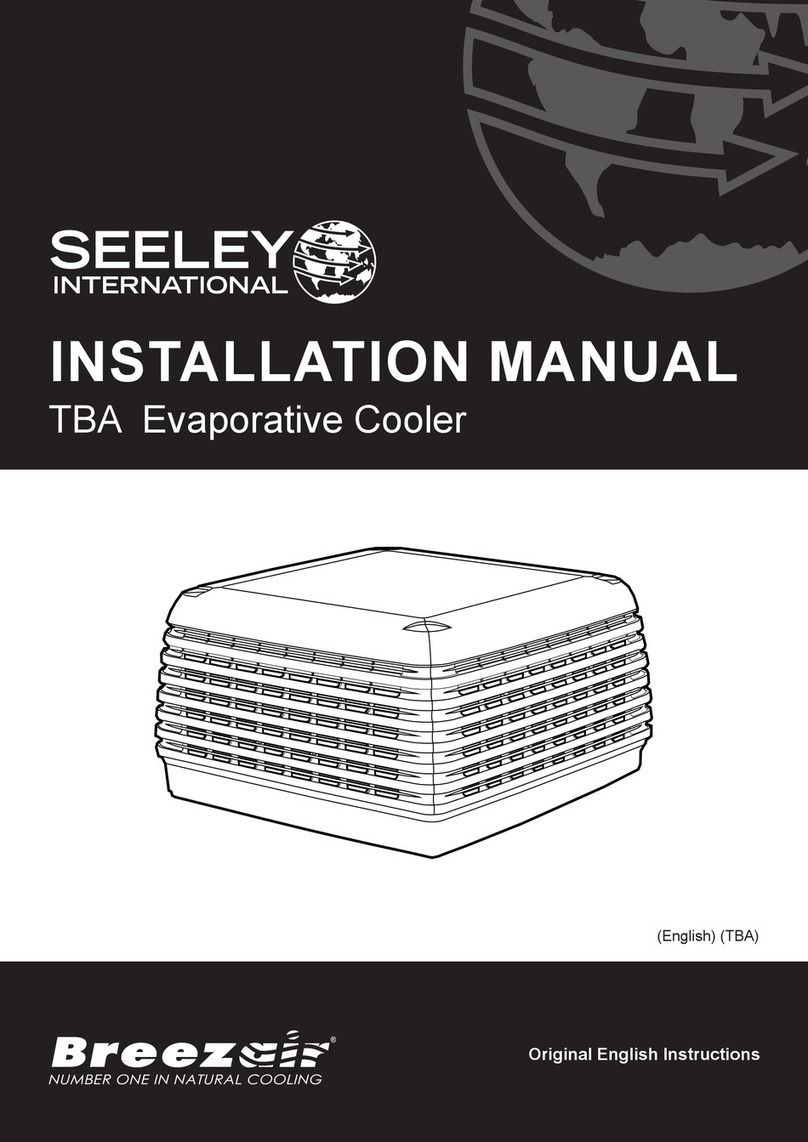
Seeley
Seeley Breezair TBA Series User manual
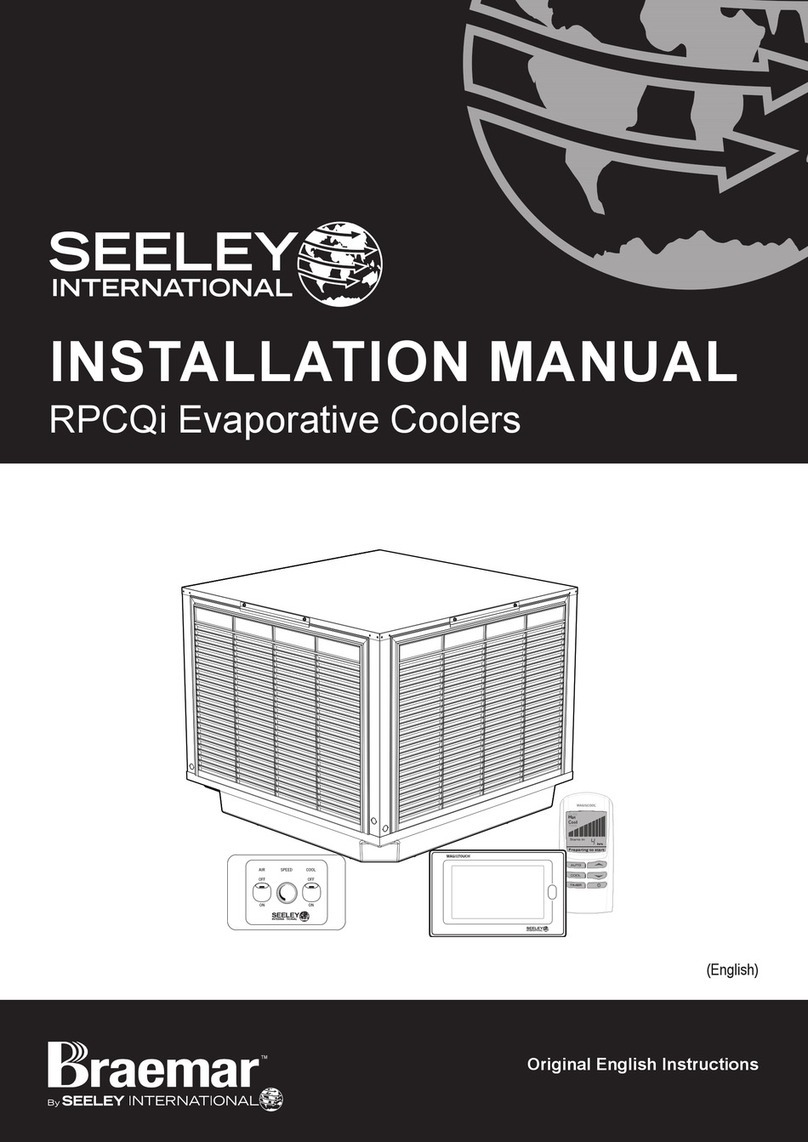
Seeley
Seeley Braemar RPCQi Series User manual
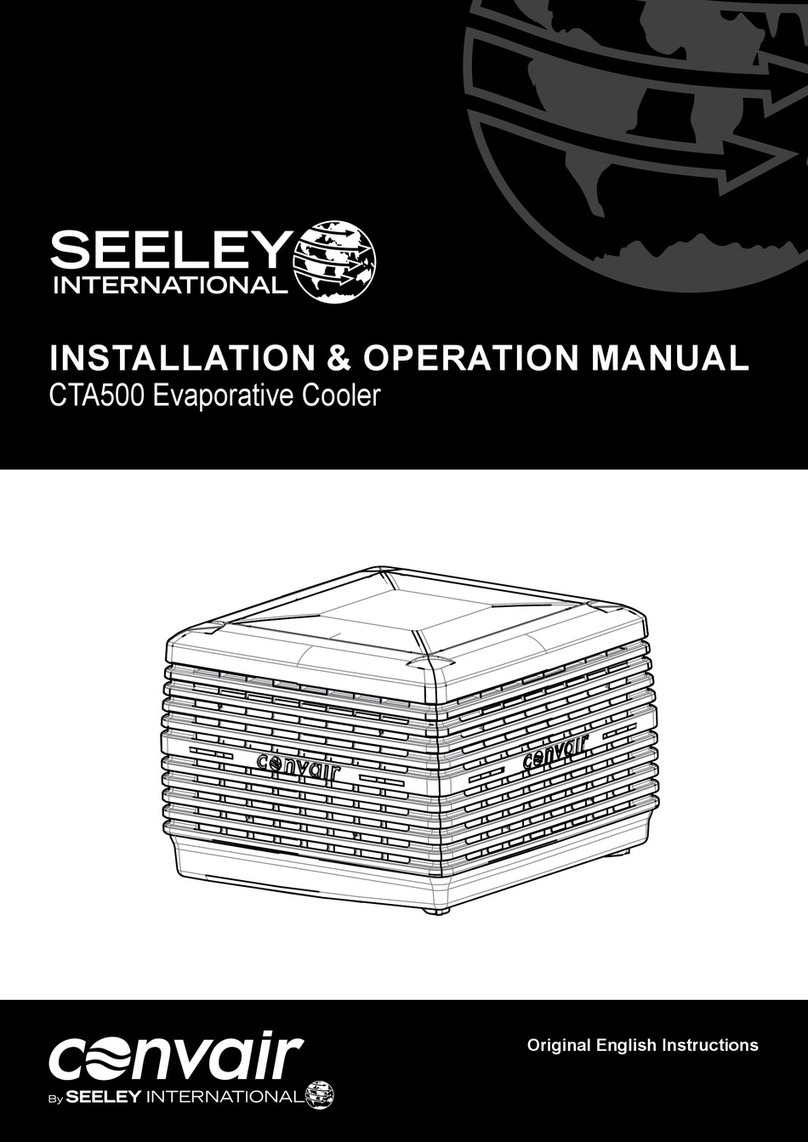
Seeley
Seeley Convair CTA500 User manual
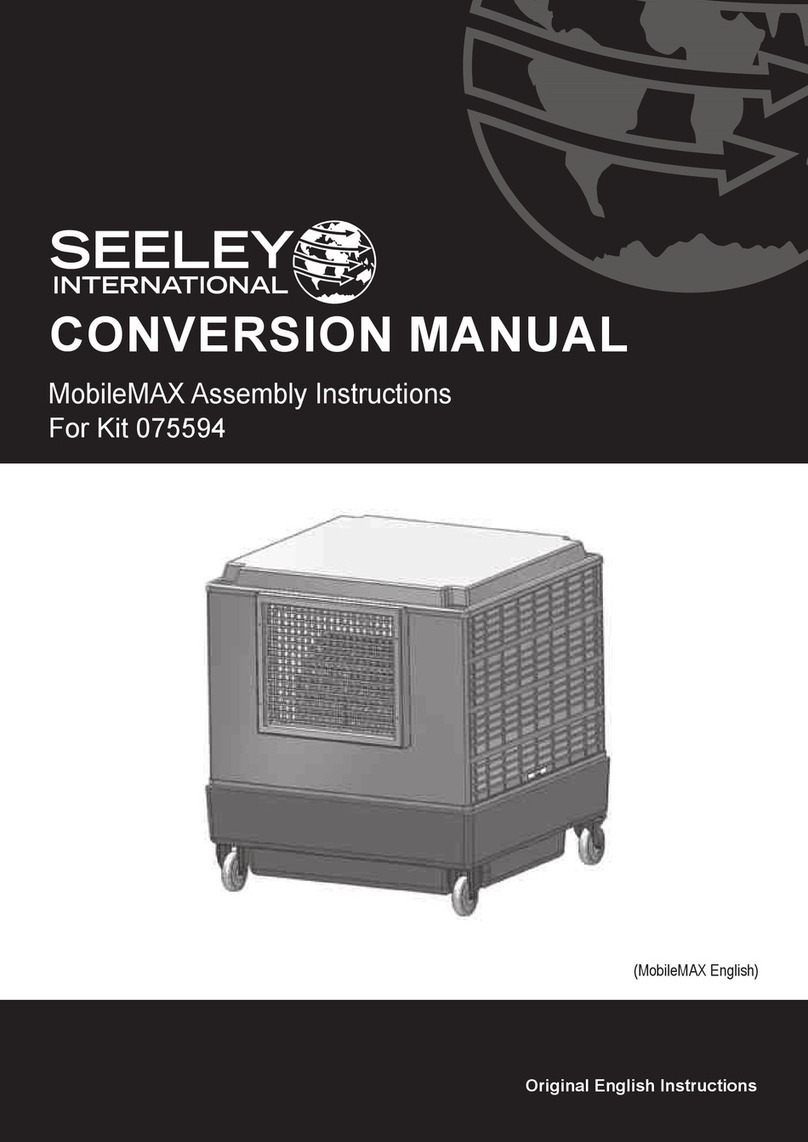
Seeley
Seeley MobileMAX Series User manual

Seeley
Seeley LCB250 User manual

Seeley
Seeley LCQ User manual
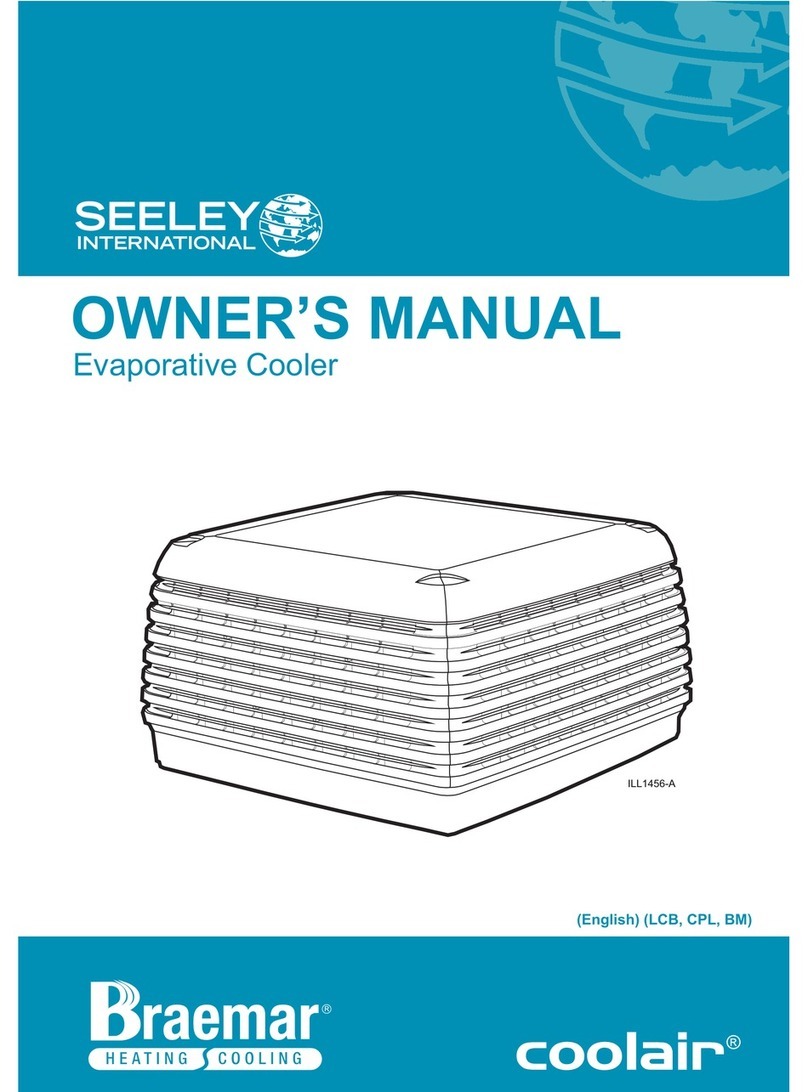
Seeley
Seeley LCB250 User manual

Seeley
Seeley TBA250 User manual

Seeley
Seeley EXQ User manual
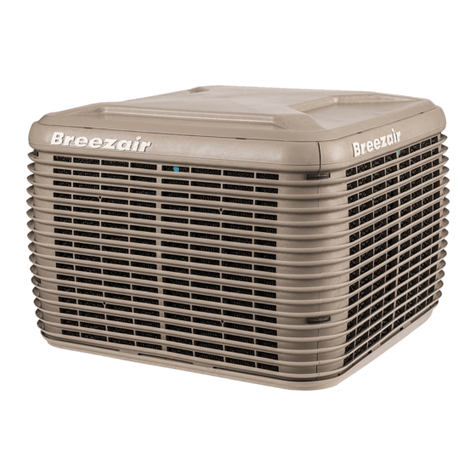
Seeley
Seeley BREEZAIR EXVQ User manual
Popular Air Cleaner manuals by other brands

Philips
Philips AC3252 user manual

Genano
Genano 200 operating instructions
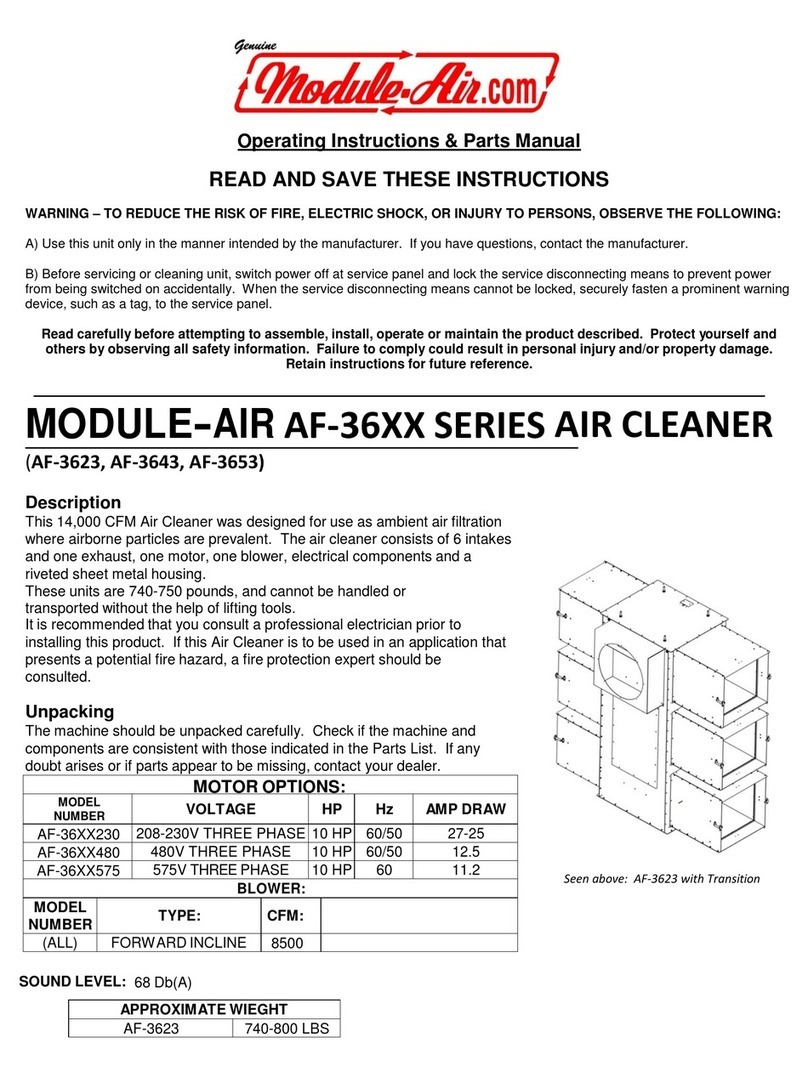
MODULE-AIR
MODULE-AIR AF-36 Series Operating instructions & parts manual
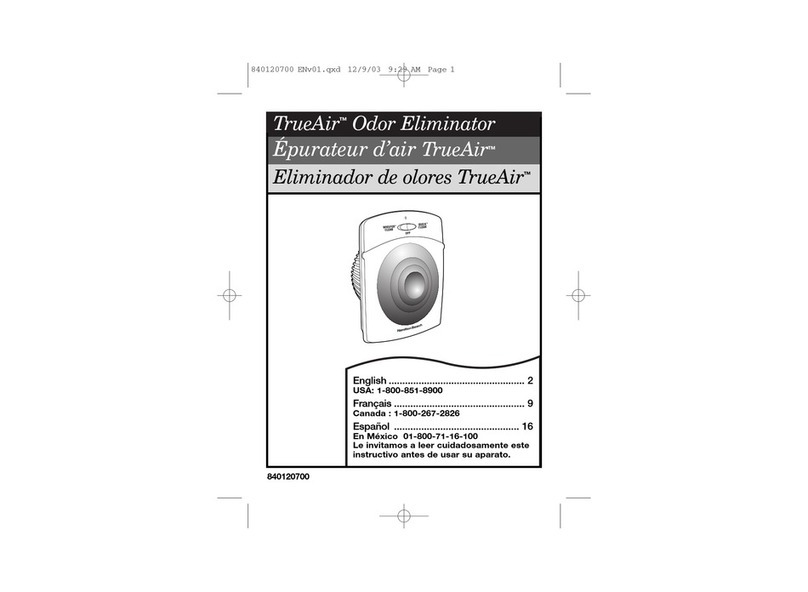
Hamilton Beach
Hamilton Beach TrueAir 840120700 Use & care guide

Power Industries
Power Industries Vapor-Eze 5100 user manual
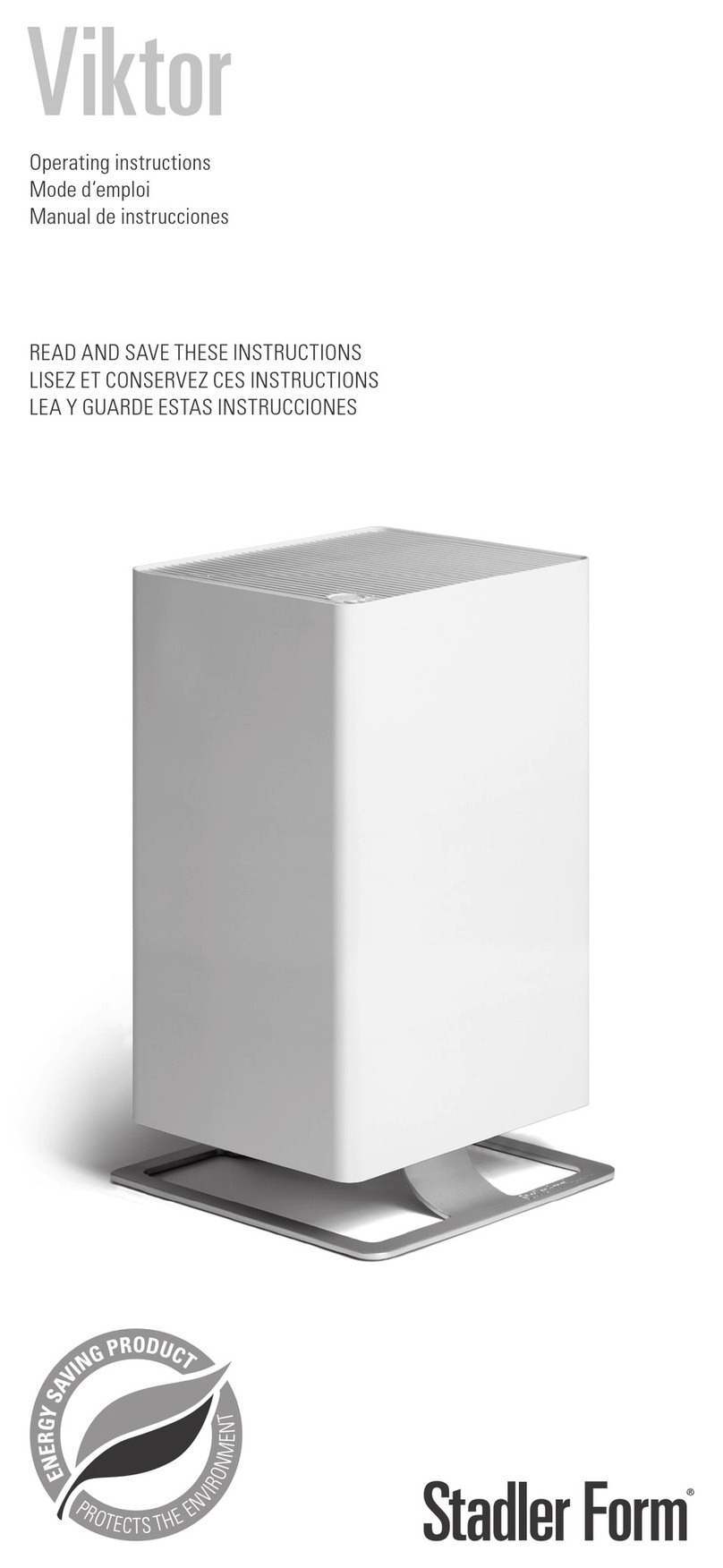
Stadler Form
Stadler Form Viktor operating instructions
